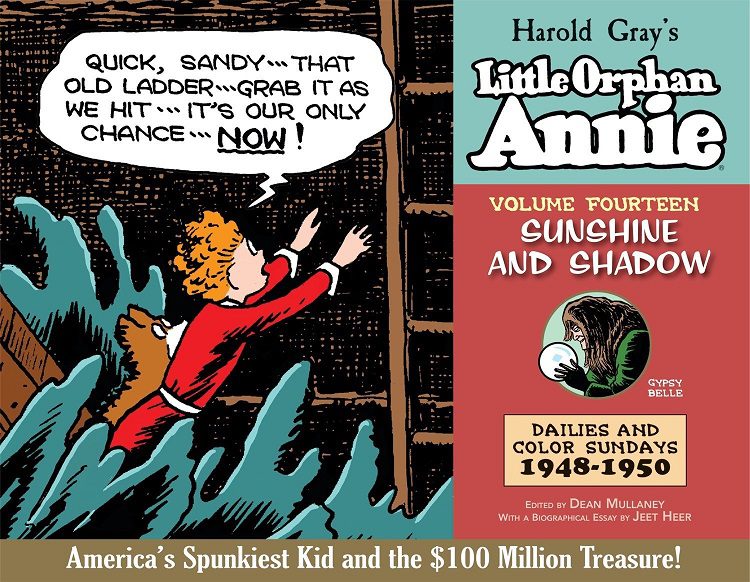
When I last checked in with Little Orphan Annie (in Volume Ten), she was busy fighting the war (World War II that is for those of you who don’t keep up with timelines of little red-haired girls in comic strips). With the war over, Annie spends the bulk of Volume Fourteen pursuing various business ventures, sparring with little mafia hoodlums, befriending a gypsy, taking on book burners, and having lots of other adventures.
Created in 1924 by Harold Gray, Little Orphan Annie ran as a daily newspaper strip until its cancellation in 2010. At its height, it was one of the most popular comic strips in the world, spawning multiple adaptations in radio, theater, and the movies. Gray wrote every strip until his death in 1964 at which time it was then covered by various writers and artists.
In its early years, the comic concentrated on Annie’s relationship with Mrs. Warbucks, who adopts her on a trial basis but continually lets her know how much she disapproves, and “Daddy” Warbucks, a rich, kind man who dotes on the child. But by the late ’40s (this book collects stories printed from August 1948 to March 1950), the Warbucks seem to be out of the picture (presumably they come back at some point). Instead, Annie is on her own, getting into mischief, wronging rights, and settling scores.
Gray was never afraid to tackle political issues in the strip and he certainly keeps that up in this volume. In the first story, Annie sets up a little shop selling candy, toys, and comics to kids but quickly runs afoul of some young hoodlums who run a protection racket. Gray lets us know his feelings on the matter, mainly that these hoodlums are the fault of “bleeding hearts” who would rather show leniency to these wayward boys rather than throw them in the slammer where they belong.
Later, Annie takes on Prissy Putsch, who wants to burn down the library as its filled with books that aren’t appropriate for children to read and might push them toward wayward ways. Annie compares Putsch to Hitler and fights back.
At the time of that story, there was another war waging in the hearts and minds of Americans. There were a great many communities who sought to destroy, burn, and outright ban comic books of all kinds. Conservatives, church groups, and the like decided that comics were teaching kids bad morals, inciting them to violence, and causing all sorts of hoodlum-ism. Communities all over the country enacted laws to ban their sale. Little Orphan Annie lets us know just how she feels about that sort of thing.
Harold Gray writes in a clear, entertaining way. The illustrations are well drawn though fairly plain and continue to feature a whole lot of people standing and talking where it could use a little more action. The stories are good and remain timely. It’s pretty incredible that a newspaper comic from the late ’40s primarily aimed at children was tackling such heavy topics. I read most of this volume together with my six-year-old daughter and she enjoyed herself nearly as much as I did even if she didn’t always grasp the politics behind the action.
As per usual, the Library of American Comics has done an outstanding job of collecting these strips. Every daily and Sunday comic from the time period are represented on large, beautifully constructed pages inside a gorgeous hardback book. It also includes an interesting essay about this period of Little Orphan Annie comics and the time period in which it was created.